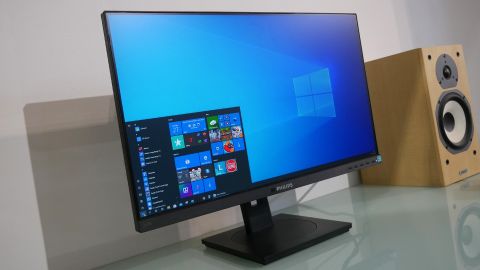TechRadar Verdict
Combining 1440p and IPS in a 24-inch package makes for an intriguingly compact productivity proposition and at a very attractive price
Pros
- +
Nice IPS panel
- +
Lots for desktop space for the size
- +
Excellent build quality
Cons
- -
No USB-C
- -
Somewhat limited colour gamut support
Why you can trust TechRadar
When it comes to business monitors, in an age where 4K seems to have assimilated everything and the assumption that bigger is better prevails, it’s easy to overlook the little guy. Enter the new Philips 245B1, part of Philips’ B Line range of productivity panels.
Overall: 4.5
Design: 4.5
Features: 4
Performance: 4
Usability: 5
Value: 4
At 24 inches, it’s one of the smallest monitors we’ve reviewed recently, if you exclude portable USB panels. But if space is at a premium, the Philips 245B1 could well be worth a look. It combines a high quality IPS panel with 2,560 by 1,440 pixels. That’s 1440p, in other words, rather than the 1080p norm for screens this size.
That gives you more desktop space, pixel density and visual precision without paying the premium for full 4K, which may be overkill for many applications, especially on a 24 inch monitor. The 245B1 has a number of other features that improve the proposition as a productivity panel, including excellent efficiency and some clever power saving features. But there’s at least one notable absence from the spec list, namely USB-C connectivity.

Price and availability
The Philips 245B1 has an RRP in the UK of £199, which is attractive given the relatively unusual combination of 24 inches, IPS and 1440p resolution. However, it’s new enough that actual retail pricing has yet to settle and the cheapest current UK offer as we write is around £240. We’d expect that to come down as availability improves. The 245B1 isn’t currently available in the US.
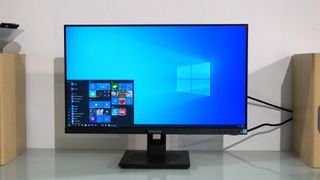
Design and features
Aesthetically, the Philips 245B1 is all black and pure business. But it’s also sleek and compact. Slim bezels on three sides of the panel ensure the 245B1 has about as small a footprint as feasible for a 24-inch monitor, adding to its appeal for applications where desk space is at a premium.
It’s a very high quality bit of kit, too, with great build quality and a stand that not only offers a full range of adjustment, including rotation into portrait mode, but also really impressive all-metal rather than plastic construction. That’s pretty exceptional at this price point.

The central attraction, of course, is a 24-inch (23.8-inch to be precise) IPS panel with 2,560 by 1,440 pixels. That translates into a pixel density of 123DPI. That’s not true high-DPI, but it is higher than many conventional displays and comparable to the pixel density of a 32-inch 4K monitor.
As for accuracy, the panel is an 8-bit item with dithering to achieve 10-bit per channel color. Philips rates the display as offering 116 per cent coverage of the sRGB gamut but doesn’t quote Adobe RGB or DCI-P3 coverage, indicating that this isn’t a display aimed at pro content creators. Likewise, don’t expect any HDR action. This is a resolutely SDR monitor rated at a modest 250cd/m2 for maximum brightness.
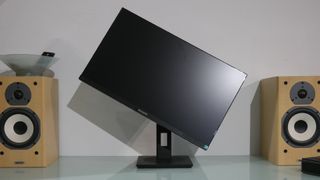
Elsewhere, you get both HDMI and DisplayPort inputs, plus DVI for some legacy connectivity. Power efficiency, meanwhile, is a significant part of the Philips 245B1’s remit. In normal operation, it’s rated at a relatively miserly 16.3 watts.
Panel size 24-inch
Panel type IPS
Resolution 2,560 x 1,440
Brightness 250cd/m2
Contrast 1,000:1
Pixel response 4ms
Refresh rate 75Hz
Vesa 100 x 100 mm
Inputs DisplayPort, HDMI, DVI
However, thanks to the infrared PowerSensor ‘people sensor’, the 245B1 can detect when the user isn’t present and reduce brightness and power consumption by fully 70 per cent. For the record it consumes 0.3 watts in standby mode and also has a zero-consumption switch.
Rounding out the main feature set is adaptive sync support, in both AMD and Nvidia flavors, and a USB hub with four USB 3.2 downstream ports, one of which offers fast charge. What you don’t get is USB Type-C for single cable connectivity to drive the display, connect peripherals and charge a laptop. That’s a pity, but not at all surprising at this price point.
For the record, the 245B1 also includes a pair of occasional use 2W speakers which will get you by in the absence of dedicated speakers.
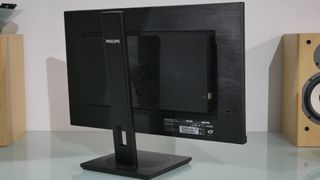
Performance
The Philips 245B1 mere 250cd/m2 maximum brightness rating doesn’t bode well for vibrancy. But in an SDR rather than HDR context, this panel has plenty of punch. Initial impressions involve crisp, natural image quality with all the attributes you’d expect from a good IPS monitor.
The viewing angles are thus excellent and the colors entirely convincing. The default factory calibration will do the job for most users, even if some compression in black tones is evident in our test images. Full calibration is possible, though in terms of preset color spaces, only sRGB is on offer. While this monitor isn’t strictly accurate enough for pro-grade content creation, it would make an interesting option if you need something that can turn its hand to some light SDR content creation on a tight budget. It‘s fundamentally a fairly accurate monitor.

On the subject of configurability, the Philips 245B1 offers three levels of pixel overdrive with which to tune response. That’s a feature more normally associated with gaming monitors, as is the support for adaptive sync. Whatever, the middle of the three settings gives good response without the ugly inverse ghosting that comes with excessive overdrive.
The 123DPI pixel pitch makes for sharp fonts and, for most users with normal eyesight, 100 per cent scaling in Windows will be comfortable, avoiding the issues that can come with setting Windows’ scaling setting above 100 per cent. The reality is that Windows’ support for true high DPI displays is still relatively poor.
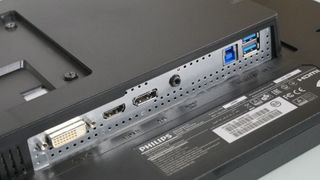
Verdict
With the slim bezels, decent desktop space, a stand that supports all manner of adjustments and overall sense of accuracy and precision, the Philips 245B1 is a great all-day working tool. Subjectively, the 1440p resolution is a huge upgrade over a 1080p 24-inch monitor and if you can source it at the £199 RRP, we’d say it’s well worth the premium over an otherwise equivalent 1080p model.
In an ideal world, we’d add USB-C connectivity to an otherwise more than adequate feature set, but the reality is that also adds significant cost. It’s also worth noting that the 245B1 isn’t suitable for true pro-grade content creation. Again, at this price point, that’s not a surprise. What it is, is a very nice productivity orientated IPS monitor that offers a very worthwhile alternative to the 24-inch 1080p norm.
- We've featured the best ultrawide monitors.
Technology and cars. Increasingly the twain shall meet. Which is handy, because Jeremy (Twitter) is addicted to both. Long-time tech journalist, former editor of iCar magazine and incumbent car guru for T3 magazine, Jeremy reckons in-car technology is about to go thermonuclear. No, not exploding cars. That would be silly. And dangerous. But rather an explosive period of unprecedented innovation. Enjoy the ride.
